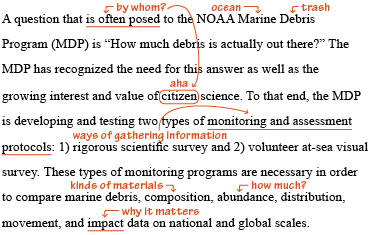Summarizing without plagiarizing
A summary condenses information and captures main ideas, perhaps reducing a chapter to a short paragraph or a paragraph to a single sentence. A summary should be written in your own words; if you use phrases from the source, put them in quotation marks.
Here is a passage about marine pollution from a National Oceanic and Atmospheric Administration (NOAA) Web site. Following the passage are the student’s annotations on the source—notes and questions that help him figure out the meaning—and then his summary of the passage. (The bibliographic information is recorded in MLA style.)
ORIGINAL SOURCE
A question that is often posed to the NOAA Marine Debris Program (MDP) is “How much debris is actually out there?” The MDP has recognized the need for this answer as well as the growing interest and value of citizen science. To that end, the MDP is developing and testing two types of monitoring and assessment protocols: 1) rigorous scientific survey and 2) volunteer at-sea visual survey. These types of monitoring programs are necessary in order to compare marine debris, composition, abundance, distribution, movement, and impact data on national and global scales.
—NOAA Marine Debris Program. “Efforts and Activities Related to the ‘Garbage Patches.’” Marine Debris, 2012, pm22100.net/
docs/ pdf/ enercoop/ pollutions/ noaa-plastiques.pdf.
ORIGINAL SOURCE WITH ANNOTATIONS
SUMMARY
Source: NOAA Marine Debris Program. “Efforts and Activities Related to the ‘Garbage Patches.’” Marine Debris, 2012, pm22100.net/
Having to field citizens’ questions about the size of debris fields in Earth’s oceans, the Marine Debris Program, an arm of the US National Oceanic and Atmospheric Administration, is currently implementing methods to monitor and draw conclusions about our oceans’ patches of pollution (NOAA Marine Debris Program).
